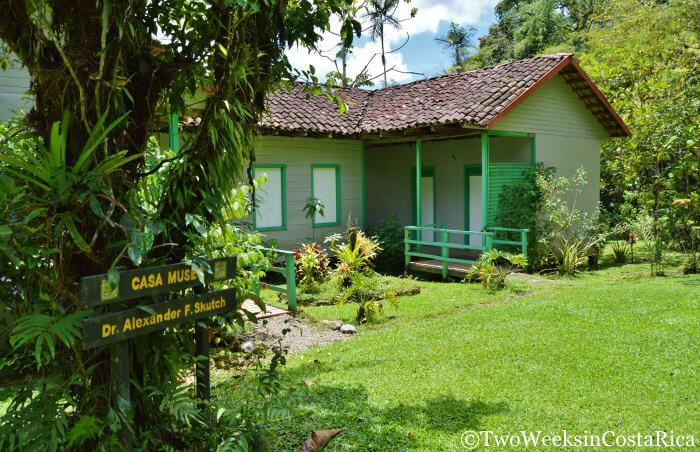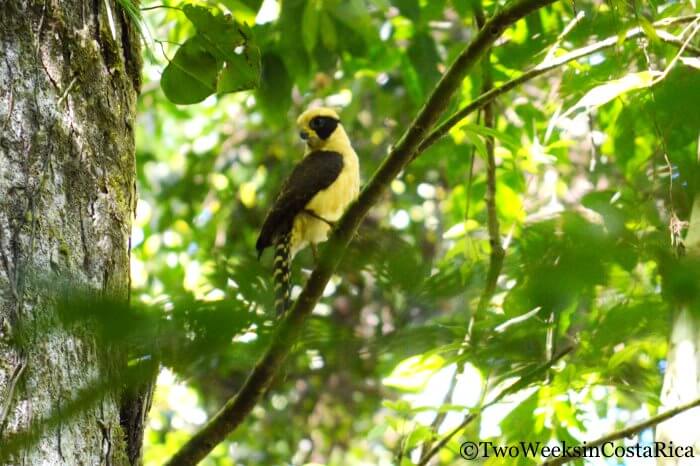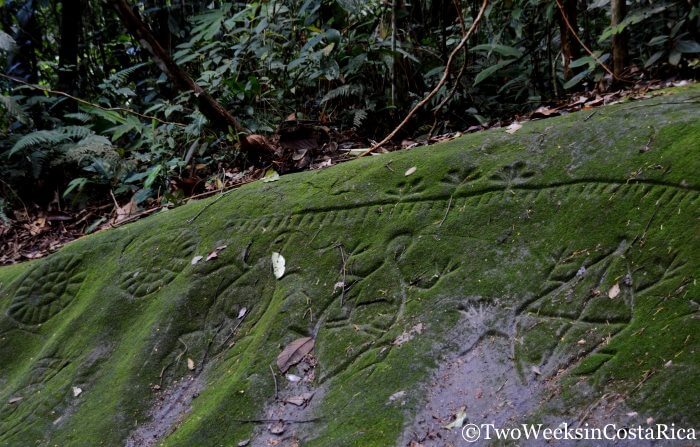Outside the world of ornithology (the study of birds), the name Alexander Skutch might not be at all familiar. But much of what the world knows today about neotropical birds is thanks to this humble naturalist who lived and studied for most of his life in Costa Rica. We recently visited the property, now nature reserve, where Skutch settled and did his research, writing about nature and most specifically birds. In this post, we’ll explain how you can visit the Los Cusingos Bird Sanctuary and also give some background so that you can appreciate this special place even more.

Overview of Los Cusingos Bird Sanctuary
Set in the countryside about 20 minutes outside the small city of San Isidro del General in Costa Rica’s Southern Zone is Los Cusingos Bird Sanctuary or Refugio de Aves Los Cusingos. This 192 acre (78 hectare) reserve once served as the home and outdoor laboratory to the late Dr. Alexander Skutch. In addition to Skutch’s simple home, the property contains a significant parcel of land for conservation and has a network of well-maintained trails that run through the adjacent tropical forest (more on this below).

About Alexander Skutch
Before visiting the sanctuary, it is nice to learn some background on Dr. Skutch. Although the facility does have some information on display as well as some of his books, there is a lot to know about this famous ornithologist and his property.

Skutch first visited the tropics as a trained botanist working for the United Fruit Company on the banana blight, which was prevalent in the 1930s. After traveling around many parts of Central America, Skutch fell in love with the beautiful birds that he saw. He realized, however, that there wasn’t a lot known about many of the species. The scientist in him decided to fix that problem. Looking for an ideal place to study nature and enjoy his new passion for birding, Skutch moved to Costa Rica in 1941 and purchased the property that now makes up the reserve. The name Los Cusingos came from the Spanish name for the Fiery-billed Aracari, a relative of the toucan, which frequented the property (see cover photo above).
Over the next 60 years, Skutch wrote or contributed to over 40 books and more than 200 scientific papers. While some of his work talked about life in the rainforest (A Naturalist in Costa Rica) and even philosophy (Harmony and Conflict in the Living World), most were on bird behavior, covering more than 300 species in great detail. His best known book on birding in Costa Rica is A Guide to the Birds of Costa Rica, which he co-authored with Gary Stiles. Many still consider this to be the best and most detailed resource for birders exploring the country (albeit heavy and somewhat cumbersome).
Check out our picks for some more backpack-friendly Costa Rica wildlife guides here.
Interesting Facts about Dr. Alexander Skutch
- Skutch didn’t support the banding of birds to study them. He instead recognized individual birds of the same species by slight differences in plumage and other markings.
- The home that Skutch built in the 1940s didn’t get running water until the 1990s. He used the nearby river as a water source until then.
- Skutch disliked raptors on his property because they were a danger to other birds. He did, however, welcome the Laughing Falcon because it ate snakes, which are also predators to birds.
- Skutch was just eight days from his 100th birthday when he died in 2004.

Planning Your Visit to Los Cusingos Bird Sanctuary
Today, Los Cusingos is managed by the Tropical Science Center, which purchased the property after Skutch’s death. The reserve is not well known to tourists so there is a good chance you will have the place all to yourself. When we visited, there was no one but staff on the grounds.
Trails
Here is a photo we took of the trail map to help you plan your visit.
From the entrance and parking area, it is an easy 2 minute walk to the home of the late Dr. Skutch. There are manicured gardens all around, but at the time of our visit, the inside of the house was not open to visitors. We have heard that there are plans in the works for a small museum sometime in the future.
From the house, there are two trails. The Naturalist trail goes farthest into the forest and is about 1 mile (1.6 km) in each direction. This trail is fairly flat and has a gravel base for a good part. There are very tall trees along this stretch, so birds were harder to identify. The last part of the trail leads to some ancient petroglyphs (carved rocks) and is a bit steeper so can be slippery.

The second trail that starts near the house is the Aves trail. This trail is only about a half mile (0.9 km) in each direction and runs parallel with the Peñas Blancas River. About halfway through the Aves trail, there is a connection to the Naturalist trail that you can use to loop back to the house or continue into the forest. Unfortunately, we didn’t have time to walk this entire trail but think that it might have been better for birdwatching because of its proximity to the river.

What You’ll See
While people mostly visit Los Cusingos for the excellent birding, we actually only counted a handful of birds on our visit because we arrived so late in the morning. On our species list were a Blue-Gray Tanager, Chestnut-Mandibled Toucan, Roadside Hawk, Great Kiskadee, Long-billed Hermit, Black-and-white Warbler, Buff-rumped Warbler, Fasciated Tiger-Heron, and an Orange-billed Sparrow.
Tip: Try to visit at peak birding times, either early morning or later in the afternoon.
Luckily, though, there is a lot more to see. Walking through the property, we saw lots of butterflies as well as some interesting insects like a neon-green Katydid (related to a grasshopper but in the shape of a leaf) and many plants and trees. The sanctuary is located deep in the forest and is very tropical so even just walking along the paths and enjoying the natural surroundings made for a nice day.
Hours
Monday to Saturday, 7:00 a.m. – 4:00 p.m.
Sunday, 7:00 a.m. – 1:00 p.m.
Special hours for birding also may be arranged with advanced reservations.
Cost
$17 adults, $6 children (foreigners)
$6 adults (foreigners with residency card)
$3 adults, $2 students, $1 children (nationals)
Guided tours are available for an additional $10. Contact the reserve to make a reservation: (506)-2738-2070 or cusingos@cct.or.cr
Directions
From San Isidro del General: Important – The bridge on Route 321 was destroyed by a storm so it is best to follow these directions – Drive south on Route 2 (Inter-Americana Highway). After the Mall (right side) continue towards Palmares. At the road for Riteve (right side) take a left off the highway and follow to the end. Take a right and follow to the small town of Penas Blancas. When you reach the Supermarket Penas Blancas, take a left onto Route 322 (not marked). Follow Route 322 for about 5-10 minutes and take a right (almost at a Y in the road) to get onto Route 326. Stay right at an intersection with signs (if you go slow you’ll see a sign for the refuge), then take a left as you go up a small hill. Follow more signs to the entrance. From downtown San Isidro the drive time is about 30 minutes.
Post updated September 2018
Have you visited the Los Cusingos Bird Sanctuary? Let us know what you thought in the comments below.

